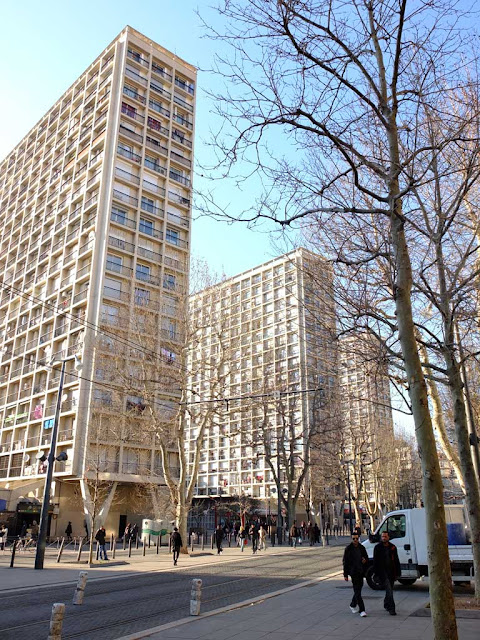Tuesday, March 13, 2012
Teufelsberg Test Post
Nevertheless, as with any other comparableurban
renewal projects, these efforts might not be reducing inequality. I
wouldargue that social tensions are fewer in Marseille than in any other
French citybecause of its socio-spatial structure. On a recent visit to
Marseille I couldwitness that on the one hand the social housing blocks
are spread all over thecity, be it in the centre or further out. On the
other hand, what is also verydistinctive and different from other
cities is that these blocks are notsurrounded by a ill-defined semi-or
quasi-public space usually in the form of a poorly maintained lawn, but
theyare interlocked with the surrounding urban fabric. Therefore their
ground levelcreates urban qualities that tower-on-the-lawn-typologies
are not able tomaintain. Hence, these structures enhance an integration
of less-affluentpopulation in the inn
Monday, March 12, 2012
Marseille La Rouviere
Websites are crucial for business and for those who make their living online. For a guy like me, all my blogs need to be monitored for downtime regularly. Since everybody knows its impossible to keep track of website downtime manually, website monitoring tools alert us through email or SMS when your website or blog goes down.
Thursday, March 8, 2012
Marseille – An Integrative Model for Inner-City Social Housing?
Unlike other French cities, Marseille’s socio-spatialstructure is distinctively different from a prevailing concentriccentre-banlieue urban landscape with outwardly growing poverty, crime, andsocial segregation. Might this specific socio-spatial distribution be a modelto diminish social tensions?
For years, especially up to the late 1970s, the city hasstruggled with frictions and inequalities that frequently have erupted inviolent riots, mainly due to the cities heterogeneous population structure. Inless then a decade, the city lost around 10% of its population throughmigration to suburbs and other cities in the Provence as a direct result ofuncontrolled violence. For years the control of violence and crime has been atop agenda for Marseille’s ruling politicians. Astonishingly, violent riots intheir grand ensembles in the last years were few compared to the rest of thecountry’s big cities. Reasons for this might be manifold.
In the hometown of Corbusier’s famous firstmachine forliving the geographical situation as the closest harbour for North-African immigrationcaused high demands in housing supplies. Therefore, and also as a consequenceof vast bombings during WW II, numerous grands ensembles (housingestates) and housing blocks had to be erected in the city in the second half ofthe 20th century. As a result the whole cityscape is interspersedwith huge concrete estates and tower blocks.
 |
| View on Old Harbour (left) and the Belsunce district. Image by SYNCHRONICITY |
Local politics argues that one limitingeffect on further street riots might be the fact that the city’s economy issteadily growing since the 1990s and new industries settle down in theMediterranean harbour city. Furthermore the government is undertaking hugeinvestments in regeneration projects and new developments such as the huge EuroMéditerranée project. Thelater involves regenerating previously derelict parts of the inner city inducingprocessesof gentrification and erecting a new seaside district close to the oldharbour. Thereby the city is following a well-known script of large-scale urbanregeneration: ‘building a city within a city’, establishing a multifunctionalnew quarter with offices, homes, commerce, recreational and culturalfacilities. Thereby they are relying on expressive architectures by well-knownarchitects such as Fuksas,Hadid,Nouvel,and Boeri.
Nevertheless, as with any other comparableurban renewal projects, these efforts might not be reducing inequality. I wouldargue that social tensions are fewer in Marseille than in any other French citybecause of its socio-spatial structure. On a recent visit to Marseille I couldwitness that on the one hand the social housing blocks are spread all over thecity, be it in the centre or further out. On the other hand, what is also verydistinctive and different from other cities is that these blocks are notsurrounded by a ill-defined semi-or quasi-public space usually in the form of a poorly maintained lawn, but theyare interlocked with the surrounding urban fabric. Therefore their ground levelcreates urban qualities that tower-on-the-lawn-typologies are not able tomaintain. Hence, these structures enhance an integration of less-affluentpopulation in the inner city districts not only through their distribution butalso through their ground-level integration. Arguably the Marseille example, might be a model to overcomethe prevalent structures of ghettoizing the poor on the city’s fringes andallows for a more heterogeneous socio-spatial distribution that consequentlyalso reduces social tensions.
 |
| Inner-city social housing in the Belsunce district with activated ground level. Image by SYNCHRONICITY |
Labels:
Marseille,
SPATIALITIES,
URBANITIES
Subscribe to:
Posts (Atom)

